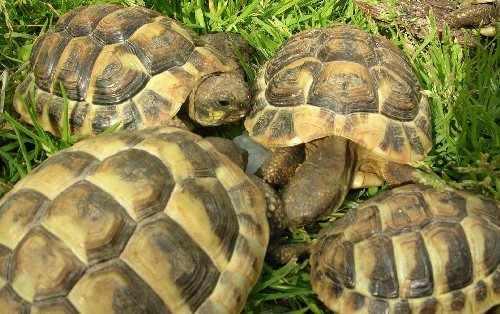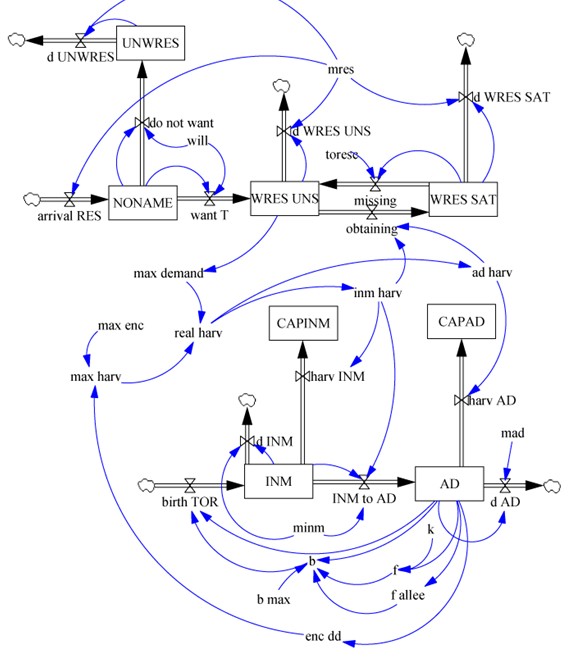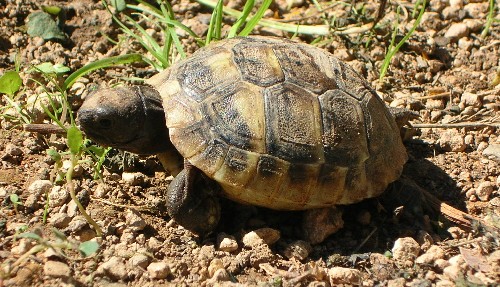Testudo graeca
Effects of exurban sprawl on population dynamics of the spur-thighed tortoise (Testudo graeca) in southeast Spain: a system dynamics approach
Irene Pérez(1), José Daniel Anadón(2), Rubén Ballestar(1), Alicia Tenza1 & Andrés Giménez(1)
1 Universidad Miguel Hernández. Dpt. Biología Aplicada, Área Ecología. Av. Universidad s/n Edif. Torreblanca, 03202 Elche, Alicante, Spain. E-mail: irene.perez@umh.es
2 Dpt. Ecological Modelling, UFZ Centre for Environmental Research, Leipzig D04301 Germany

Exurban sprawl is one of the most important threats to biodiversity. Together with the direct effects of urbanization (e.g. habitat loss and fragmentation), the practices of residents toward native species (such us feeding, collecting…) in new exurban areas could be crucial for conservation.
I explore this issue by studying the effects of population growth due to ex-urban sprawl on the collection and captivity of an endangered terrestrial tortoise (Testudo graeca, spur-thighed tortoise) in southeast Spain. Spain, especially southeast Spain, is one of the main tourist destinations in the world, and the construction of second homes for retired foreign people, mainly from north Europe, is an important economic activity. The main population of the spur-thighed tortoise in Europe is located in southeast Spain. This species is highly endangered and, nowadays, the loss of rural and natural areas to urban and suburban environments is the main threat factor for the conservation of Testudo graeca in this area. The main threat after habitat loss is the collection of tortoises from wild populations to be kept as pets. The practice of keeping tortoises in captivity as a domestic animal is not new. The species has been frequently collected from wild populations by rural inhabitants motivated by popular beliefs and by the commerce of tortoises as pets. However, owing to the rural depopulation since the fifties and the species protection by Spanish law in the early seventies, the collection of tortoises from wild populations has decreased considerably. The important repopulation within the distribution area of Testudo graeca, mainly due to ex-urban sprawl through international tourism, may lead to an increased habit of tortoise collection. This situation may mean that the collection of this species once again becomes a decisive problem for Testudo graeca conservation in southeast Spain.
I made a conceptual diagram to represent the effect of collecting individuals of spur-thighed tortoise by residents of new exurban areas in southeast Spain. The development of this model will allow explore the long-term effects of the practices of collect tortoises from wild population.
The conceptual diagram, as is shown in figure 1, included two submodels interconnected through tortoises collected: tortoise population dynamic and new residents dynamic. Table 1 shows the specification of all the variables used in the construction of the model.
Spur-thighed tortoise life history parameters will be derived from scientific bibliography and own data. Parameters values of the residents submodel will be obtained by means of interviews to new residents of residential areas within the distribution area of the species.
Figure 1. Conceptual diagram of the model used to predict the impact of exurban sprawl on spur-thighed tortoise population. Level variables are represented in boxes and flow variables in valves, the rest being auxiliary variables, data and constants. The specification of all variable codes is expressed in table 1.

Table 1. Specification of all variables considered in the dynamic model developed.
INM - Inmatures population size
AD - Adults population size
CAPINM - Acumulated number of captive immature tortoises
CAPAD - Acumulated number of captive adult tortoises
mad/minm - Mortality of adults/inmatures
b - Reproduction rate
k - Carrying capacity
f - High density denso-dependency factor on reproduction
f_allee - Low density denso-dependency factor, Allee effect, on reproduction
bmax - Maximum reproduction rate
UNWRES - Residents unwilling to have tortoises
WRES - Residents willing to have tortoises but without enough tortoises (unsatisfied)
WRES_UNS - Residents willing to have tortoises with tortoises (satisfied)
nres - Number of residents
will - Proportion of residents willing to have a tortoise
mres - Mortality of residents
torres - Mean number of tortoises per resident
toresc - Captive tortoise exporting rate (dead or given)
max_demand - Maximum tortoise demand
max_enc - Maximum encounter rate
enc_dd - Denso-dependency encounter factor
max_harv - Maximum harvesting
real_harv - Real harvesting
dif_detec - Differential detection of inmatures/adults
inm_harv - Inmature harvesting
ad_harv - Adult harvesting

|